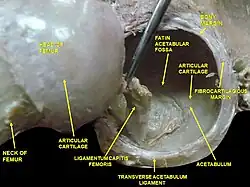| Lunate surface of acetabulum | |
|---|---|
 | |
| Details | |
| Identifiers | |
| Latin | facies lunata acetabuli |
| TA98 | A02.5.01.006 |
| TA2 | 1312 |
| FMA | 43524 |
| Anatomical terms of bone | |
The lunate surface of acetabulum is the articular surface of the acetabulum which makes contact with the femoral head as part of the hip joint. It forms an incomplete ring that is deficient inferiorly - opposite the acetabular notch. The lunate surface surrounds the central, non-articular depression - the acetabular fossa - which does not make contact with the femoral head in the articulated hip joint.[1]
Its surface consists of articular cartilage. It is widest (and the cartilage thickest) anterosuperiorly where weight is transmitted from the lower limb in an upright position; it is narrowest at its pubic portion.[1]
References
- 1 2 Standring, Susan (2020). Gray's Anatomy: The Anatomical Basis of Clinical Practice (42nd ed.). New York. p. 1368. ISBN 978-0-7020-7707-4. OCLC 1201341621.
{{cite book}}: CS1 maint: location missing publisher (link)
This article is issued from Wikipedia. The text is licensed under Creative Commons - Attribution - Sharealike. Additional terms may apply for the media files.